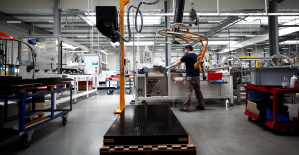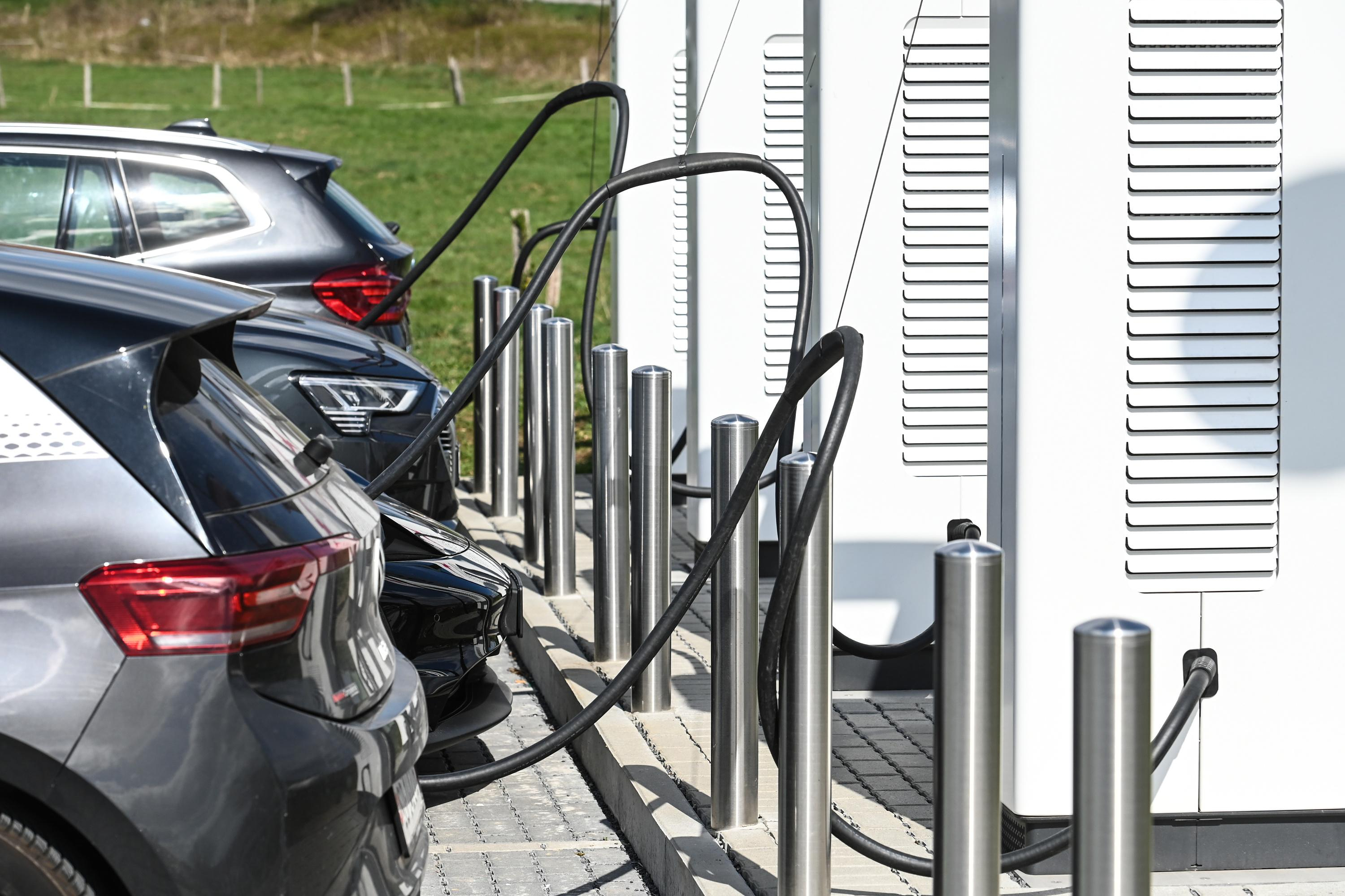Suddenly the mountains disappeared in the fog. You could just see them at the train station in Chur. Now Peter Briner gently pushes the gas lever forward with his right hand and slowly drives his train towards a roundabout. A travel agency passes by on the right, in whose shop window you can read the holiday offers, it's so leisurely. mountain railway? Well, this feels like a tram ride.
At the crossing, the cars are all red, the train has the right of way. Peter Briner, a man with gray hair, round glasses and a good mood, says: "Almost boring." He doesn't mean the old town, but the order on the streets in the oldest city in Switzerland. When he started at the Rhaetian Railway 30 years ago, there was still anarchy. Black-and-white photos captured scenes of cars jostling around the track and pedestrians jumping over the rails.
The train creeps along the old town of Chur, the gateway to the Swiss Alps. But there is still nothing to be seen of them. The Arosa train, which Briner is driving this morning, boasts of its views of two and a half thousand meter peaks. One curve further, past the Maltese Tower and the river promenade, you come to the Chur-Altstadt stop. Here mountains are finally looming up again on the horizon, phew, the fog is clearing.
Even as a boy, Peter Briner wanted to be a train driver, today he drives trams, mountain railways and freight trains - all at the same time, because the Arosa line combines all of these: It begins as a tram in Chur's old town and then climbs over 26 kilometers and 1150 meters in altitude, the six percent steep route up to Arosa, often with freight cars in tow.
Briner says he has one of the nicest jobs in Switzerland. Because the Arosa Line is one of the most picturesque mountain railway routes in Helvetia. Word hasn't got around, however, as it's overshadowed by the legendary Bernina Express (from Chur across the Alps to Tirano) and the Glacier Express (from St. Moritz to the Matterhorn), both of which are overrun by tourists.
But in none of the famous railways is there such a variety within an hour as on the Arosa Line: historic rows of houses, the adventurous Schanfigg Valley, mountain villages, gorges, fairytale forests and of course the Langwieser Viaduct, an icon of Graubünden. On one of his many trips to Arosa, Thomas Mann described the route as follows: “Travel here on the mountain railway, amazing.” It must mean something when the writer, who tends to use long sentences, is so brief.
The train rolls out of town, past an old train depot. The Plessur, a mountain river, winds its way into the valley on the right. Peter Briner pushes the cruise control up to 30 kilometers per hour. The train doesn't get much faster, more than 35 km/h is not possible, the route is too steep for a higher speed.
So it's a leisurely climb to the top. A few alpine huts cling to the slope, a waterfall rushes over the rocks. You can stick your head out the window, breathe in the cool mountain air, smell the tart scent of the spruce trees and catch a few snowflakes in winter.
The first tunnel. The train creeps slowly through the darkness, the light from its lamps feeling its way along the stone walls. A curve, daylight again, and suddenly there is this sharp cliff edge. The slope drops a good 100 meters to the right, below the river looks like a small trickle. "It's crazy that you could build a railway here," says Briner.
The Schanfigg valley, shaped by agriculture for thousands of years, was long considered sleepy. Until a small place called Arosa was discovered as a health resort and the canton of Graubünden had a road built to Langwies in 1876, from where guests could hike to Arosa in two and a half hours, up to 1800 meters.
The Schanfiggerstrasse enabled the village to gain momentum as a tourist destination, writes the author Ueli Haldimann in a book contribution on the occasion of the 100th anniversary of the inauguration of the train in 1914. The railway brought further traffic. Thousands of people suffering from tuberculosis came to Arosa every year, where the mountain air was supposed to heal their lungs. The population increased twenty-fold in just one generation.
The railway fever in Arosa was triggered by the construction of the Bernina Railway, which later became world famous, in 1906. The idea of a railway line was also circulating in the Schanfigg valley at the time, writes Haldimann. A complicated undertaking, the train finally had to overcome 1150 meters in altitude.
In March 1910, the Arosa municipal assembly decided to build an electrified narrow-gauge adhesion railway, which would be driven by the static friction of the wheels. 7.6 million francs were earmarked for the construction and two years time. A mammoth project.
Construction work began in August 1912 in order to save time at different points at the same time. However, the building materials could not be brought up by train from the valley as usual. So they mainly used material that the mountain provided along the route. In some places natural stone, higher up debris deposits from the glaciers, which were perfect for concrete production.
That's why the famous Langwieser viaduct is made of concrete. Horse-drawn carriages set off from Chur around 1,000 times to bring iron and cement to the construction site, writes Ueli Haldimann. At that time, the viaduct was considered to be the largest reinforced concrete bridge in the world at a height of 62 meters and a length of 284 meters. A masterpiece of engineering, still an attraction for the canton of Graubünden.
Workers dug 19 tunnels through the rock, totaling nearly a mile and a half. They built 27 stone bridges, three of iron and two of concrete. According to Haldimann, a good 2,000 men are said to have been employed at the time. Almost everything went according to plan.
Only the First World War nobody here had foreseen. Despite the departure of many workers and a lack of building materials, the first car actually drove to Arosa on November 21, 1914, and the line went into operation three weeks later.
At the St. Peter-Molinis train station, a man in an orange jacket and white helmet raises his hand in greeting, Peter Briner waves back. The construction worker's colleagues are repairing a bridge and the rails, there is almost always a construction site along the route. At the beginning of the millennium, they renovated the Langwieser Viaduct over seven years, this year the last tunnel before Arosa.
The station building behind the man in the work jacket is typical for the route. The wood on the facade is dark, the window shutters are red and above the balcony there is a saying: "Do not fear the world, attack bravely." Such sayings adorn the station buildings along the entire route. They come from the construction period of the railway and make it clear which ones spirit of optimism the train brought to Schanfigg.
Behind St. Peter-Molinis only picturesque mountains - mighty, snow-covered peaks on the horizon, Weisshorn, Rothorn and Hörnli to the right, Schatzalp and Weissfluhjoch straight ahead. The train rattles over the Gründjitobel viaduct, on the left the “Steinmannli”, conical blocks of stone scraped by the weather that look like thick stalagmites.
Of all the seasons, Peter Briner likes autumn best, especially when the sunlight breaks through the golden treetops. If it weren't for the larch needles on the rails. When the train crushes them, they become slippery as soft soap, so Briner even has to add a bit of braking power when going uphill to give the train better grip on the rails.
Briner also likes the glistening snow cover in winter. The train simply clears away the snow on the rails, a plow is attached at the front. A good half of all skiers who come to Arosa take the train to the mountain village, the lift starts right at the train station. Peter Briner then takes thousands of people in anoraks and ski boots into the mountains every day.
In Langwies, the penultimate stop before Arosa, a trolley is waiting, loaded with tree trunks. One of the trains will later pull him down into the valley. The Rhaetian Railway brings concrete, gravel and sand up to Arosa and used glass, rubbish and wood down into the valley.
In the short construction season in summer, things happen in quick succession. "Sometimes I think I'm driving a freight train instead of a passenger train," says Peter Briner. That's not entirely true: every year, a good half a million passengers travel by train, especially in winter and midsummer.
As the doors at the station close, Peter Briner presses the throttle forward and heads for the highlight of the route: the Langwieser Viaduct. The train bumps onto the viaduct like a rollercoaster ride. Below, the Plessur rushes through the scree. It's a brief moment of floating - with a view of farmhouses and the mountain peaks. Every crossing is also a highlight for Briner: "It's almost like flying!"
Then comes the final climb. The rails lead through a snowy forest, the train climbs a few more meters. Sometimes, says Briner, he even sees deer hopping between the trees from the driver's cab – a view befitting one of the loveliest workplaces in Switzerland.
Getting there: Take the Intercity via Zurich to Chur (sbb.ch). A ticket for the Chur-Arosa line costs CHF 15.20 (rhb.ch). The journey takes a good hour, best view uphill in the direction of travel on the right.
Accommodation: Accommodation in Arosa is available from around 120 francs per night. Offers on arosalenzerheide.swiss.
Further information: myswitzerland.com
Participation in the trip was supported by Switzerland Tourism. You can find our standards of transparency and journalistic independence at axelspringer.com/de/Werte/downloads.
Extreme athlete Markus Eder and his team have been working on the perfect descent for two years - and that's the result.
Source: WELT/Stefan Wittmann
This article was first published in December 2021.

 Germany: the trial of an AfD leader, accused of chanting a Nazi slogan, resumes this Tuesday
Germany: the trial of an AfD leader, accused of chanting a Nazi slogan, resumes this Tuesday New York: at Columbia University, the anti-Semitic drift of pro-Palestinian demonstrations
New York: at Columbia University, the anti-Semitic drift of pro-Palestinian demonstrations What is Akila, the mission in which the Charles de Gaulle is participating under NATO command?
What is Akila, the mission in which the Charles de Gaulle is participating under NATO command? Lawyer, banker, teacher: who are the 12 members of the jury in Donald Trump's trial?
Lawyer, banker, teacher: who are the 12 members of the jury in Donald Trump's trial? What High Blood Pressure Does to Your Body (And Why It Should Be Treated)
What High Blood Pressure Does to Your Body (And Why It Should Be Treated) Vaccination in France has progressed in 2023, rejoices Public Health France
Vaccination in France has progressed in 2023, rejoices Public Health France Food additives suspected of promoting cardiovascular diseases
Food additives suspected of promoting cardiovascular diseases “Even morphine doesn’t work”: Léane, 17, victim of the adverse effects of an antibiotic
“Even morphine doesn’t work”: Léane, 17, victim of the adverse effects of an antibiotic Orthodox bishop stabbed in Sydney: Elon Musk opposes Australian injunction to remove videos on X
Orthodox bishop stabbed in Sydney: Elon Musk opposes Australian injunction to remove videos on X One in three facial sunscreens does not protect enough, warns L'Ufc-Que Choisir
One in three facial sunscreens does not protect enough, warns L'Ufc-Que Choisir What will become of the 81 employees of Systovi, a French manufacturer of solar panels victim of “Chinese dumping”?
What will become of the 81 employees of Systovi, a French manufacturer of solar panels victim of “Chinese dumping”? “I could lose up to 5,000 euros per month”: influencers are alarmed by a possible ban on TikTok in the United States
“I could lose up to 5,000 euros per month”: influencers are alarmed by a possible ban on TikTok in the United States Dance, Audrey Hepburn’s secret dream
Dance, Audrey Hepburn’s secret dream The series adaptation of One Hundred Years of Solitude promises to be faithful to the novel by Gabriel Garcia Marquez
The series adaptation of One Hundred Years of Solitude promises to be faithful to the novel by Gabriel Garcia Marquez Racism in France: comedian Ahmed Sylla apologizes for “having minimized this problem”
Racism in France: comedian Ahmed Sylla apologizes for “having minimized this problem” Mohammad Rasoulof and Michel Hazanavicius in competition at the Cannes Film Festival
Mohammad Rasoulof and Michel Hazanavicius in competition at the Cannes Film Festival Skoda Kodiaq 2024: a 'beast' plug-in hybrid SUV
Skoda Kodiaq 2024: a 'beast' plug-in hybrid SUV Tesla launches a new Model Y with 600 km of autonomy at a "more accessible price"
Tesla launches a new Model Y with 600 km of autonomy at a "more accessible price" The 10 best-selling cars in March 2024 in Spain: sales fall due to Easter
The 10 best-selling cars in March 2024 in Spain: sales fall due to Easter A private jet company buys more than 100 flying cars
A private jet company buys more than 100 flying cars This is how housing prices have changed in Spain in the last decade
This is how housing prices have changed in Spain in the last decade The home mortgage firm drops 10% in January and interest soars to 3.46%
The home mortgage firm drops 10% in January and interest soars to 3.46% The jewel of the Rocío de Nagüeles urbanization: a dream villa in Marbella
The jewel of the Rocío de Nagüeles urbanization: a dream villa in Marbella Rental prices grow by 7.3% in February: where does it go up and where does it go down?
Rental prices grow by 7.3% in February: where does it go up and where does it go down? Europeans: “All those who claim that we don’t need Europe are liars”, criticizes Bayrou
Europeans: “All those who claim that we don’t need Europe are liars”, criticizes Bayrou With the promise of a “real burst of authority”, Gabriel Attal provokes the ire of the opposition
With the promise of a “real burst of authority”, Gabriel Attal provokes the ire of the opposition Europeans: the schedule of debates to follow between now and June 9
Europeans: the schedule of debates to follow between now and June 9 Europeans: “In France, there is a left and there is a right,” assures Bellamy
Europeans: “In France, there is a left and there is a right,” assures Bellamy These French cities that will boycott the World Cup in Qatar
These French cities that will boycott the World Cup in Qatar Serie A: Bologna surprises AS Rome in the race for the C1
Serie A: Bologna surprises AS Rome in the race for the C1 Serie A: Marcus Thuram king of Italy, end of the debate for the position of number 9 with the Blues?
Serie A: Marcus Thuram king of Italy, end of the debate for the position of number 9 with the Blues? Milan AC-Inter Milan: Thuram and Pavard impeccable, Hernandez helpless… The tops and flops of the derby
Milan AC-Inter Milan: Thuram and Pavard impeccable, Hernandez helpless… The tops and flops of the derby Ligue 2: Auxerre leader, Bordeaux in crisis, play-offs... 5 questions about an exciting end of the season
Ligue 2: Auxerre leader, Bordeaux in crisis, play-offs... 5 questions about an exciting end of the season


















